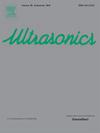Ultrasonic Leaky Rayleigh Wave Imaging Using Extended Phase Shift Migration and Image Fusion
IF 3.8
2区 物理与天体物理
Q1 ACOUSTICS
引用次数: 0
Abstract
Ultrasonic leaky Rayleigh wave enables easy automated detection of surface or sub-surface defects due to its non-contact detection advantages. The existing leaky Rayleigh wave detection methods using single transducer suffer from low focused energy and short detection range. To solve these problems, this paper adopts the detection method of leaky Rayleigh wave generated by phased array, and proposes an imaging algorithm using extended phase shift migration (EPSM) and image fusion. Firstly, the virtual source-based extended phase shift migration (VSEPSM) algorithm is proposed to enhance the effective detection distance by increasing the energy of the transmitting elements. Then, the fast Fourier transform (FFT) interpolation algorithm is employed to enhance the lateral detail representation in EPSM and VSEPSM imaging, improving the imaging quality. Finally, a custom image fusion method is used to perform arithmetic processing on the imaging amplitudes at corresponding positions in EPSM and VSEPSM imaging, merging the detection advantages of EPSM and VSEPSM at different distances. Compared to traditional time-domain full focusing (TFM) imaging, the imaging algorithm proposed in this paper achieves better imaging performance for defects at relatively distant locations, with a 5.94 dB increase in average signal-to-noise ratio (SNR) and a 61.4% improvement in imaging efficiency. This provides an effective method for detecting surface and sub-surface defects in the industrial field.
基于扩展相移偏移和图像融合的超声漏瑞利波成像
超声波泄漏瑞利波由于其非接触式检测的优点,可以方便地自动检测表面或亚表面缺陷。现有的单传感器泄漏瑞利波检测方法存在聚焦能量低、检测距离短的问题。针对这些问题,本文采用相控阵产生的泄漏瑞利波检测方法,提出了一种扩展相移偏移(EPSM)和图像融合的成像算法。首先,提出了基于虚拟源的扩展相移偏移(VSEPSM)算法,通过增加发射单元的能量来提高有效探测距离;然后,采用快速傅里叶变换(FFT)插值算法增强EPSM和VSEPSM成像中的横向细节表示,提高成像质量;最后,采用自定义图像融合方法对EPSM和VSEPSM成像中对应位置的成像幅值进行算法处理,融合EPSM和VSEPSM在不同距离的检测优势。与传统的时域全聚焦(TFM)成像相比,本文提出的成像算法对较远位置缺陷的成像性能更好,平均信噪比(SNR)提高了5.94 dB,成像效率提高了61.4%。这为工业领域的表面和亚表面缺陷检测提供了一种有效的方法。
本文章由计算机程序翻译,如有差异,请以英文原文为准。
求助全文
约1分钟内获得全文
求助全文
来源期刊

Ultrasonics
医学-核医学
CiteScore
7.60
自引率
19.00%
发文量
186
审稿时长
3.9 months
期刊介绍:
Ultrasonics is the only internationally established journal which covers the entire field of ultrasound research and technology and all its many applications. Ultrasonics contains a variety of sections to keep readers fully informed and up-to-date on the whole spectrum of research and development throughout the world. Ultrasonics publishes papers of exceptional quality and of relevance to both academia and industry. Manuscripts in which ultrasonics is a central issue and not simply an incidental tool or minor issue, are welcomed.
As well as top quality original research papers and review articles by world renowned experts, Ultrasonics also regularly features short communications, a calendar of forthcoming events and special issues dedicated to topical subjects.
 求助内容:
求助内容: 应助结果提醒方式:
应助结果提醒方式:


